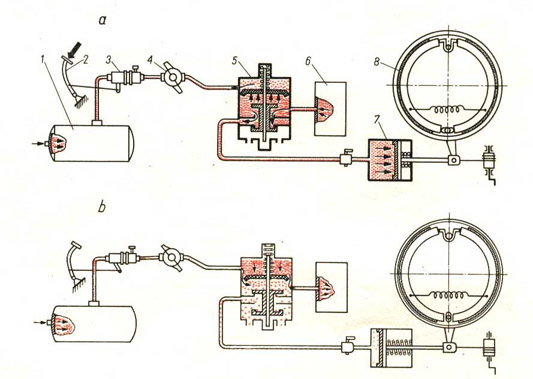 The pneumatic actuator allows the brakes to be controlled by compressed air (overpressure air 4-10 at. The pressure of the driver's foot on the brake pedal is not transmitted to the brake shoes, but only opens a valve that directs compressed air to the brakes. The advantages of the air brake system include: possibility of obtaining very high braking forces with low pressure on the brake pedal, possibility of simultaneous braking of trailers towed by a car or a tractor, the possibility of using compressed air for the device supporting the steering system, for inflating tires, opening doors on buses, etc.. The disadvantage of this system, however, is the immobilization of the brakes then, when the engine is not running for a long time, rap. when towing a car. The pneumatic brake actuator is folded: - from the compressor, driven by the engine and forcing air into the tank, - actuating valve (control unit), connected to the brake pedal and providing air flow to the diaphragm chambers when the pedal is pressed, - diaphragm chambers, performing the task of air spreaders and causing pressing the jaws to the brake drums by means of cam spreaders, - safety valve, limiting the maximum air pressure in the brake system, - from the piping system (stiff and flexible), connecting the compressor and actuating valve to the air reservoir. A motor driven compressor forces air through a safety valve into the pre-tank, and after filling it - into the main tank through the check valve. When the brake pedal is depressed, the actuating valve opens and deflates air from the inlet tank to the diaphragm chambers, located at all wheels. Pressing the air on the diaphragms, the spreaders are rotated, which press the shoes against the brake drums. The braking force depends on the degree of air compression. After the driver releases the pressure on the brake pedal in the control valve (actuator) the inlet valve closes, and it opens the outlet, which causes the pressure in the system to drop to atmospheric pressure. The air in the diaphragm brake chambers escapes to the outside and the rams return to their previous position, not braking. While driving, when the air pressure in the brake system becomes excessively high, the safety valve opens automatically and releases some air to the atmosphere. In some heavy-duty vehicles and road tractors, the braking intensity can be adjusted depending on the degree of vehicle load.. For this purpose, it is provided at the control valve (actuator) lever, which can occupy three positions: vehicle unladen, half loaded, fully loaded.
The pneumatic actuator allows the brakes to be controlled by compressed air (overpressure air 4-10 at. The pressure of the driver's foot on the brake pedal is not transmitted to the brake shoes, but only opens a valve that directs compressed air to the brakes. The advantages of the air brake system include: possibility of obtaining very high braking forces with low pressure on the brake pedal, possibility of simultaneous braking of trailers towed by a car or a tractor, the possibility of using compressed air for the device supporting the steering system, for inflating tires, opening doors on buses, etc.. The disadvantage of this system, however, is the immobilization of the brakes then, when the engine is not running for a long time, rap. when towing a car. The pneumatic brake actuator is folded: - from the compressor, driven by the engine and forcing air into the tank, - actuating valve (control unit), connected to the brake pedal and providing air flow to the diaphragm chambers when the pedal is pressed, - diaphragm chambers, performing the task of air spreaders and causing pressing the jaws to the brake drums by means of cam spreaders, - safety valve, limiting the maximum air pressure in the brake system, - from the piping system (stiff and flexible), connecting the compressor and actuating valve to the air reservoir. A motor driven compressor forces air through a safety valve into the pre-tank, and after filling it - into the main tank through the check valve. When the brake pedal is depressed, the actuating valve opens and deflates air from the inlet tank to the diaphragm chambers, located at all wheels. Pressing the air on the diaphragms, the spreaders are rotated, which press the shoes against the brake drums. The braking force depends on the degree of air compression. After the driver releases the pressure on the brake pedal in the control valve (actuator) the inlet valve closes, and it opens the outlet, which causes the pressure in the system to drop to atmospheric pressure. The air in the diaphragm brake chambers escapes to the outside and the rams return to their previous position, not braking. While driving, when the air pressure in the brake system becomes excessively high, the safety valve opens automatically and releases some air to the atmosphere. In some heavy-duty vehicles and road tractors, the braking intensity can be adjusted depending on the degree of vehicle load.. For this purpose, it is provided at the control valve (actuator) lever, which can occupy three positions: vehicle unladen, half loaded, fully loaded.